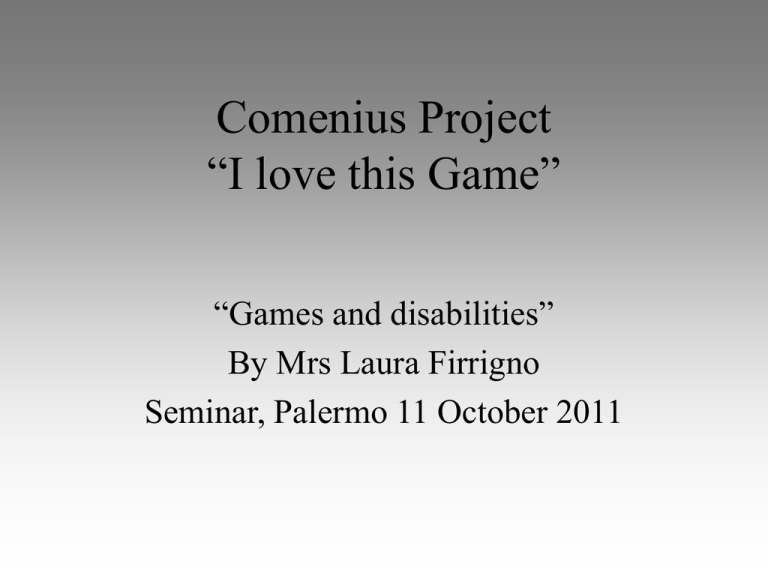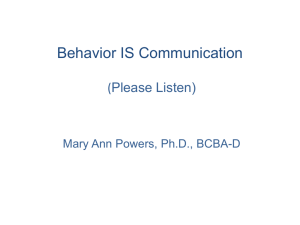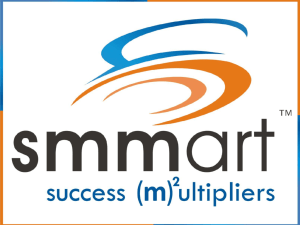Behavior - WordPress.com
advertisement

Comenius Project “I love this Game” “Games and disabilities” By Mrs Laura Firrigno Seminar, Palermo 11 October 2011 PROGRAMMING FORMULATION OF A PLAN THAT ADDRESSES THE ACTION FOR THE ACHIEVEMENT OF CERTAIN AIMS APPROACH COGNITIVE-BEHAVIORAL INTEGRATES THERAPY AND BEHAVIOR MODIFICATION (TMC) WITH ELEMENTS OF COGNITIVISM. Behaviorism: BRANCH OF PSYCHOLOGY BASED OF BEHAVIOR (HUMAN AND ANIMAL) ANALYSIS, REFUSING METHODS OF SURVEY NOT OBJECTIVELY VERIFIABLE. ANALYSIS AND MODIFICATION OF BEHAVIOR (ABA) Principles and guidelines for achieving specific objectives programs. Basic options: determinism, environmentalism, R-Sr Basics: observation, task analysis, skill, manipulation of antecedent and consequent, use of specific techniques for increasing or decreasing behaviors. THE PRESENT PANORAMA SEES THE INTEGRATION OF THE COGNITIVIST MODEL COGNITIVISM BRANCH OF PSYCHOLOGY THAT GIVES PRIORITY TO COGNITIVE PROCESSES IN DETERMINING INDIVIDUALBEHAVIOR Main cognitive modules: Ellis's rational-emotive therapy: psychological disorders are the result of erroneous and irrational cognitive schemas Self-instruction training: language guides the individual behavior Beck's cognitive therapy: modification of cognitive schemata improves adaptation to the environment. Integrates behavioral and cognitive tasks. Human information processing: input-process-output framework, the TOTE (test operate test exit) replaces the SR; program cycle based on feedback in a self-regulating system Some cognitive-behavioral modules: Bandura's social learning theory: behavior, personal and environmental factors are a network of causal relationships Multimodal approach of Lazarus: behavioral disturbances are the result of the interaction of behavior, emotions, sensations, cognition, imagination, interpersonal relationships and pharmacological effects. Cognitive-behavioral approach to disability Determinism: behavior has a cause (biological bases, cognitive structures, environment) Environmentalism: many causes of disease lie in the environment (physical, interpersonal and organizational) Location: many causes of behavior lie in situations where the person with disability is inserted PROGRAMMING Dual-track: ENVIRONMENT (adaptation of environment, demands of the environment.) PERSON (skills, capabilities) Flowchart of the Programming phases ASSESSMENT Assessment: Analysis and assessment of skills, capabilities and deficiencies,through direct and indirect procedures. WHAT TO OBSERVE: behavior PARAMETERS: frequency duration intensity FUNCTIONAL BEHAVIOR ANALYSIS PROVIDES ADDITIONAL INFORMATION TO DIRECT OBSERVATION, CONCERNING BEHAVIOR DYNAMICS. SCHEME A-B-C ANTECEDENTS CONSEQUENTIALS BEHAVIORS (Especially used in case of problem-behaviors) EXSAMPLE OF FUNCTIONAL ANALYSIS Behavior functional analysis FOGLIO DI OSSERVAZIONE DEI COMPORTAMENTI PROBLEMATICI ORARIO LUOGO O ATTIVITA’ TIPO DI COMPORTAMENTO MESSO IN ATTO DAL BAMBINO COSA E’ ACCADUTO QUALE PUO’ ESSERE COSA E’ QUALE E’ STAT A IMMEDIATAMENTE IL MOTIVO CHE HA ACCADUTO LA REAZIONE DEI PRIMA (1) SCATENATO IL SUBITO DOPO GENITORI/ COMPORTAMENTO OPERATORI (2) 1. Cosa faceva il bambino? Cosa facevate voi? Cosa facevano gli altri bambini? Cosa accadeva nell’ambiente? 2. C’è qualcosa che non ha capito? Qualcosa che non ha potuto realizzare? QUALE E’ STATA LA REAZIONE DEL BAMBINO ALLA LORO REAZIONE FORMULATION OF OBJECTIVES Formulation of Objectives • Long-term objectives (over the year). Balance in the relationship between present and future • Mid-term objectives (3 months - 1 year). REALISM - PRIORITY '- PROBABILITY' OF SUCCESS • Immediate educational goals Goal = terminal behavior, ie performance the child must show at the end of the teaching. itinerary • accuracy, observability, measurability Formulation of objectives Elements that constitute the objective: behavior, conditions, criteria Behavior: what the child has to do Conditions: the material and content, instruction, factors that may facilitate or hinder performance. (CONTROL BY THE STIMULUS) Mastery criterion: the goal is reached when the performance will be produced for some time. 100%: max level of mastery; 70-80% minimum Parameters: Speed - Accuracy - amounts Formulation of objectives TASK ANALYSIS: operation through which each objective is broken down into its basic components a) isolate, describe and sequence the components of the task b) explore and describe the prerequisites needed to run each of the component parts. EXSAMPLE OF TASK ANALYSIS USE THE FORK Take a fork Put it close to the plate Skew the food Bring the fork with food in your mouth • CRITERIA FOR OBJECTIVES FORMULATION : EASE FUNCTIONALITY POSSIBILITY 'OF GENERALIZATION MODULARITY ECONOMY In order to develop the objectives ask : • • • • • Will be functional? Is the level appropriate? Will increase the level of inclusion in school? Can the target be generalized? Does it take into account the priorities of the class? • Does it use the strength points and interests? • Does it is proceed gradually? IMPLEMENTATION OF STRATEGIES ACTION TECHNIQUES TECHNIQUES : structured strategies aimed at behavior modification • Techniques that increase the probability of emission of a behavior • Techniques that increase and / or reduce the possibility of emission of a behavior • Techniques that reduce the probability of emission of a behavior The choice of technique must be based on the characteristics of the person INCREASE STRATEGIES REINFORCEMENT event that, presented immediately after the behavior, increases the probability of emission RINFORZI SEGNO ORIGINE CONTENUTI COLLOCAZIONE HABITAT POSITIVO PRIMARI TANGIBILI INTRINSECO NATURALE NEGATIVO SECONDARI SOCIALI ESTRINSECO ARTIFICIALE DINAMICI SIMBOLICI • POSITIVE REINFORCEMENT: increases the probability of a behavior, the situation that precedes the appearance of behavior is neutral or positive • NEGATIVE REINFORCEMENT: increases the probability or frequency of a behavior that eliminates a state of uneasiness or discomfort, so the situation that precedes the appearance of behavior is negative • PRIMARY REINFORCEMENT: unconditioned reinforcement, its properties are innate (eg., Foods) • SECONDARY REINFORCEMENT: learned or conditioned reinforcement (eg., Money) • EXTRINSIC REINFORCEMENT external to the person and behavior • INTRINSIC REINFORCEMENT: inside the person and behavior • NATURAL REINFORCEMENT lies in the person's life • ARTIFICIAL REINFORCEMENT used in order to promote learning EXTRINSIC REINFORCEMENT CONTENT TANGIBLE ENHANCER edible inedible DYNAMIC ENHANCER: activities SOCIAL ENHANCER : praise, appreciation SYMBOLIC ENHANCER: tokens to exchange with one or more of the above enhancers REINFORCEMENT PROGAMM CONTINUOUS INTERMITTENT RELATED DURATION FIXED VARIABLE ReinforcementRules • • • • Select different enhancers (menu ') Give the child a choice Use them only after the desired behavior Switch from an intermittent to a continuous reinforcement • Switch from artificial to a natural reinforcement INCREASE STRATEGIES SHAPING: reinforcement of behaviors that are closer and closer to the action end (goal or behavior), that is the behavior that you want to teach. Modeling and reinforcement are always integrated You must define the behavior/ the goal and the various sub-goals necessary to achieve it, from the beginning Each stage must be adequately reinforced Record the progress accurately to base the transition to the next step on objective information. Example of Shaping e modeling INCREASE STRATEGIES Prompting and errorless learning technique of stimulus control, consisting of external help added to the starting point, to facilitate the emission of appropriate behavior VERBAL AID (specific delivery; suggestion; indirect delivery) PHYSICAL HELP HELPING HAND VISUAL AID (figural, colored cardboard, written word, etc.) MODEL HELP PROMPT RULES Give only the minimum aid Decrease gradually the evidence of the prompt (fading) Wait a few seconds after aid administration before using it again INCREASE STRATEGIES FADING Gradual reduction of outside provided aid, to promote the highest possible level of autonomy. Fading of verbal prompt * contents * tone Physical Prompt Fading * Progressive reduction of contact * Progressive reduction of the intensity of contact * removal from the contact point from to be performedfocal action fading imitation * Gradual decrease of the model Fading of gestural prompt • reduction in the size of gesture * Replacement of the gesture with a less evident (eg., replace the touch with the look) Prompt Fading Visual * Progressive reduction of dimensions * Progressive reduction of traits number * Progressive reduction of intensity Increase strategies CHAINING construction of a chain with single stocks of the terminal behavior, previously learned by modeling, Anterograde speaking, that is, starting from the first and ending with the last action, or retrograde direction, ie starting with the last action and ending with the first. • The activity is split into its components From the start the chaining mode is established (anterograde or retrograde) and also the mode of reinforcement The behaviors are repeated in close temporal contiguity until the whole chain becomes an automatic sequence INCREASE STRATEGIES MODELING Learning skills through observation of a model modeling gradual (eg, motor skills of increasing difficulty) Driven model (demonstration and help of the observer) Symbolic model (through moving or still images) Covert modeling Modeling by peers (tutoring) Decrease Strategies Less restrictive treatment model Level 1: positive techniques (eg, differential reinforcement) Level 2: positive techniques + frustration (differential reinforcement/ extinction) Level 3: positive techniques + frustration + punishment (differential reinforcement + extinction + time out or physical block or other punishing techniques) DIFFERENTIAL REINFORCEMENT Reinforcement of other behavior (DRO) or incompatible behaviors (DRI) with deleting behavior In addition, but not always Extinction of problem behavior by eliminating reinforcers which maintain it EXTINCTION To ignore the problematic behavior and remove enhancers Main forms of extinction: social sensory EXTINCTION It is not always easy to identify enhancers of the problematic behavior The intervention should be adopted by all in the same way The surgery must be systematic Has to product a state of frustration EXTINCTION LIMITS The extinguishing behavior tends to recur Sometimes the behavior is greatly increased especially at the beginning The inappropriate behavior can be replaced by other PUNISHMENT Type A Delivery of aversive stimulation (verbal, physical, meta-verbal) as a result of conduct, aimed at its reduction. Type B Stealing enhancers Disadvantages and side effects of punishment: reduces only temporarily the behavior you want to delete, in the long run it tends to recur with unchanged frequency produces anxiety and leads to avoidance or escape behaviors (real leak, lies, unconditional acquiescence with the punisher). Anxiety is then stimulated by the very presence of the person who punishes. The person in a state of anxiety has difficulty both in learning new skills and in performing the already learned. tasks Disadvantages and side effects of punishment: Punishment may cause a reaction of aggressiveness against the punisher or another person. The person who punishes becomes an aggressive model and may lead to imitative processes by identifying with the model. The punishment is a form of attention, even if negative, and can reinforce maladoptive behaviors COMPOSITE TECHNIQUES TOKEN ECONOMY and EDUCATION CONTRACT Use of symbolic enhancers and following exchange with support reinforcement (usually tangible). Often associated with the technique: COST OF RESPONSE Applicable to individuals and groups. APPLICATION RULES : Clearly define the behaviors to reinforce and punish Producing a rich list of support reinforcements To establish an optimal relationship between number of tokens and support reinforcements (inverse relationship between satisfaction and appreciation of the reinforcement directly proportional between reinforcement and approval and number of tokens) Establish an optimal relationship between severity of inappropriate behavior and cost to be paid Clearly define the moments in which you exchange reinforcement tokens TRAINING FOR 'SOCIAL SKILLS : use of different techniques for the acquisition of adaptive social behavior Techniques : modeling, role reversal, feedback, self-education, muscle relaxation Example of steps to follow: Identification of deficits Video recording in the natural situation and comment modeling Role reversal Videotaping and feedback Repetition of the behavior generalization In cases of severe disability are used prompting and reinforcement TUTORING Entruste peer the educational responsibility of the partner. Why? Enhance learning (the tutor uses a simpler linguistic code) Encourage positive relationships between students with disabilities and peers (in order to that tutors must vary) Promote the empowerment of the class TUTORING How? Choosing a mentor (motivation, appropriate communication skills; ability to adapt its behavior to the response of the companion, self-control) Features of the training (training of tutors; simulations) Using multiple tutors The tutor is reinforced by the operator (vicarious reinforcement) only in the first part of the procedure and in turn reinforces the companion. In the second phase vicarious reinforcement is eliminated GENERALIZATION The generalization should be programmed Types of generalization: task (eg., toilet reading labels functional objects and their variable-color, shape, size, material, etc..) environment (various child’s living environments of external environment) people (moving from operator to other people, adults and peers) CHECK check Determination of: Degree of effectiveness and efficiency of treatment (outcome) Degree of effectiveness and efficiency of the process (on the methodologies and report) Degree of effectiveness and efficiency of the techniques (techniques) Degree of treatment efficacy: demonstration of connection between action and outcome, excluding, as much as possible, other factors groups: control group that doesn’t make the treatment - the group that makes a "placebo" – group that makes the experimental treatment: input and output measurements Thank you For attention !








